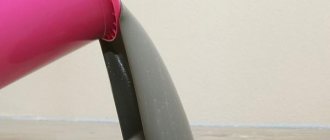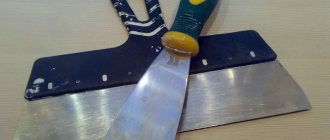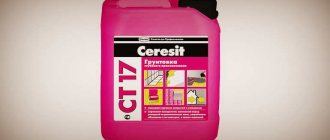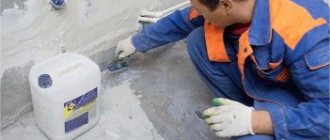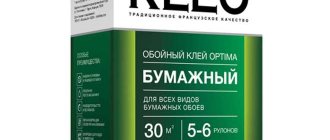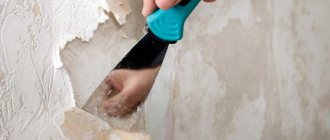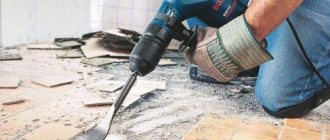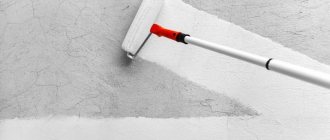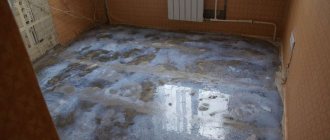The finishing of the walls of premises begins with the stage of priming them. The primer solution serves to obtain a smooth and rough coating, which will help to obtain a high degree of adhesion to further materials. Applying a primer is an important part of finishing work; without it, it will be difficult to obtain a finish without flaws. To carry out repairs faster, you need to calculate in advance how much primer is needed per 1 square meter of wall, then you can immediately purchase the required amount of product. More details on what determines the primer consumption per 1 m2 of wall will be discussed below.
What determines primer consumption?
The average consumption of the product is always specified in the instructions for the product, but it is calculated for ideal operating conditions, without taking into account individual repair conditions. The primer can be applied to drywall, plaster, concrete, wood and other substrates. Different substrates require the use of different types of primer. The calculation must be carried out taking this into account.
Also, how much primer will be needed per 1 m2 will be influenced by the purpose of the work being done. There are universal and specialized formulations on sale; their consumption will vary. There are several main factors that influence the amount of mixture used:
- Type of base;
- Ingredients and ratio of components specified by the manufacturer;
- The type of paint, glue and other materials that will be used to secure the finish;
- Season and weather conditions.
The type of tool with which the composition will be applied plays an important role.
Different substrates require the use of different types of primer.
What factors influence changes in the proportions of soil consumption rates?
In addition to the above factors, there are other components that need to be taken into account when calculating the amount of primer mixture. You need to pay attention to the following points:
- The structure of the treated surface, if the work is carried out, for example, with an aerated concrete base, then the solution will be applied in larger quantities, because its structure is porous and will absorb more material;
- Type of primer, primer mixtures vary in purpose, and their type will affect consumption;
- The number of layers that will be applied, naturally, two layers will require more primer than one;
- Temperature and humidity indicators in the room where the work is being carried out. It is better to work in a dry and warm room.
It is better to work in a dry and warm room.
Types of primers
Today, various types of primers are produced. Liquids are used for different surfaces. The main types include:
- acrylic, which is universal, it can be used to cover various surfaces to be finished (concrete, brick, fiberglass wallpaper for painting), used on fiberboard, chipboard panels, wooden, plastered bases;
- alkyd is recommended for finishing wood, used on metal substrates (outside and inside), but mixtures are recommended for use inside buildings, the composition is unsuitable for processing drywall and plastered surfaces (as a result, fleecy irregularities arise), solutions are considered more suitable for impregnating untreated wood, chipboard and fiberboard;
- phenolic, which is used to coat metal and wooden substrates;
- perchlorovinyl is universal, but is used only for finishing work on the outside of buildings;
- Griftal is considered the most effective; it is used exclusively for covering the external walls of buildings;
Griftal primer for drywall sheets
- Polystyrene is used to process plastered, concrete bases, and brick surfaces; it is a toxic material, and therefore is not intended for interior work.
From all of the above it follows that the best option for processing drywall is acrylic. Video review of existing types of primers.
Primer consumption rate depending on surface characteristics
The rate of consumption of mixtures is greatly influenced by the type of material; different manufacturers produce mixtures with different compositions, this causes differences in consumption rates. Next, the most popular types of soil will be considered.
The rate of consumption of mixtures is greatly influenced by the type of material.
Primer consumption for metal per 1 m2
To treat a metal base, you need to select special mixtures that do not contain acrylic, since it does not prevent the formation of rust on the metal. It is advisable to carry out preparatory work on the metal surface in case of rusty areas. If this step is skipped, then the consumption will vary from 120 to 200 grams.
For this material, you should choose epoxy primers; this type can also be used when working with concrete. Their average consumption is 60-100 grams. Special anti-corrosion compounds for metal are produced; their norm is 80 grams per square meter of surface.
For this material, you should choose epoxy primers; this type can also be used when working with concrete.
Concrete contact
Concrete contact "Optimist" is used for concrete surfaces and is characterized by a high adhesive property. They also note that the product dries in a short time, which saves time on repairs. The primer forms a rough structure on the surface, on which various finishing materials fit well. The average consumption indicated by the manufacturer is 350 g/sq.m.
However, experts in practice have found that consumption can vary from 200 to 500 grams.
Concrete contact "Optimist" is used for concrete surfaces and is characterized by a high adhesive property.
The use of Knauf primer is also popular; the consumption rate of this brand is 250-350 g/sq.m. m. It is better to use it in combination with Knauf Rotband plaster, the result will be of high quality.
It is best used in combination with Knauf Rotband plaster.
Deep penetration soil
This type is chosen when it is necessary to process a porous material; the composition is able to penetrate deeply into the base, filling the material. A coating with an increased level of adhesion is obtained. Can be used for various types of materials.
Deep penetration primer consumption per 1 m2 can vary between 90-180 g. But when making calculations, one should not forget about the surrounding factors influencing this process.
The composition is able to penetrate deeply into the base, filling the material.
Acrylic and facade primers
The acrylic type is easily soluble in water; powders or ready-made versions of primers can be sold. Their shape is similar to whitewash, so they are suitable for working with light-colored surfaces. The consumption of acrylic primer per 1 m2 of wall is 120-150 grams. They can be used for interior finishing and for exterior work before applying putty or other facing materials.
The acrylic type is easily soluble in water; powders or ready-made versions of primers can be sold.
For facade work, it is usually necessary to spend 150 g per square meter of area. We can note the products of Ceresit CT 17, which are popular when processing house facades. Cerezit ST can be used before puttying work or laying other types of wall cladding.
We can note the products of Ceresit CT 17, which are popular when processing house facades.
Primer selection
Usually the packaging indicates what kind of work the liquid is intended for and the primer consumption. To decide which composition is best to choose, it is necessary to familiarize yourself with this information. The primer must have the following basic characteristics:
- Good penetrating ability.
- Increase the adhesion of the base.
- Bind dust.
- Resistant to chemical influences.
- Not toxic.
- Ensure continued uniform application of the finish.
- Reduce consumption (per 1m2) of paint or wallpaper glue.
- Dry quickly.
It must be a moisture-resistant and heat-resistant liquid. Typically the primer is a white or colorless composition. Some white liquids become yellowish after drying. Therefore, you should know what kind of finishing the walls are planned with gypsum plasterboard.
For example, a colorless solution of Ceresit 17 is often used for priming drywall for further painting. When you plan to glue wallpaper, you can buy a white solution (if the coating is paper, then it is better to choose a colorless solution). Before painting, it is necessary to apply a colorless primer (it is recommended to choose the “Universal” option).
When choosing a solution, it is recommended to give importance to:
Indoor drywall tile primer should be used for interior work. You cannot use façade; it contains substances prohibited for work in residential and public buildings. It is not always recommended to use universal formulations. To get the best results, you should better choose special solutions.
Stages of priming plasterboard walls
The use of different types of compositions leads to the fact that less materials are wasted, and the finish lasts better. Which liquid works best and where is easily determined by the chemical composition of the solution. This factor determines the surfaces on which the composition is most effective.
How to calculate primer consumption per 1 m2 of wall
When you need to calculate how many packages of primer mixture you will need to buy for repair work, you need to start by assessing the working conditions. It is worth deciding in advance on the brand of primer and the application tool. Taking these factors into account will help you correctly calculate the number of packages.
When you need to calculate how many packages of primer mixture you will need to buy for repair work, you need to start by assessing the working conditions.
Consumption proportions of the main types of primer
Each calculation is done individually, precisely because of the factors described above that affect material consumption. However, there are averages that can help a beginner calculate the amount of mortar for finishing walls. So experts indicate the following figures:
- Alkyd – 120 grams;
- Water-dispersed – 100 grams;
- For subsequent application of decorative plaster mixture – 200 grams;
- For wallpaper and universal compositions – 120 grams;
- Concrete contact – 350 grams.
Each calculation is done individually.
Proportions for deep penetration primers
Deep penetration primers are selected for different purposes, but they are most optimally used to cover porous surfaces. They are distinguished by the requirement for good filling of the structure and the creation of a good level of adhesive properties. This type helps to obtain high strength characteristics of the finish. An example of this primer: Prospectors – 200ml/sq.m.
The consumption of deep penetration primer per 1 m2 is 90-180 g. The indicator is influenced by the climate, the quality of the wall, ceiling or floor where the composition will be applied. And of course the base material itself.
This type helps to obtain high strength characteristics of the finish.
Acrylic composition consumption proportions
Acrylic primer can be powdered or ready-made. The first option is mixed with water before use, the ratio is indicated by the manufacturer. It is important to strictly adhere to these data in order to obtain the declared properties.
The acrylic type is white in color, so if you need to prime a dark wall, it is better not to use this option, it simply will not be able to cover this shade.
The finished product can be immediately applied to the surface; you just need to stir it a little so that the sedimentary part rises. Approximately 130-150 g/sq.m. is spent on surface treatment. m.
The finished product can be applied to the surface immediately; you just need to stir it a little so that the sedimentary part rises.
Priming functions
Priming improves a number of characteristics of the base intended for subsequent finishing:
- A waterproofing film is formed on the surface.
- The adhesive properties of the surface are improved.
- The top of the material is significantly strengthened.
Applying a primer before filling gypsum board sheets increases the service life of the surface and significantly reduces the degree of water absorption. Some types of solutions contain antibacterial additives. Then the composition protects surfaces from the effects of fungi, mold and other bacteria.
Drywall must be primed, then the putty will apply better. Pre-treatment increases adhesion to finishing materials.
Due to the improvement in the properties of bases coated with the composition, there is a reduction in the consumption of putty for drywall, paint, and decorative plaster.
Scheme for applying primer to a plasterboard ceiling
A deep penetration primer provides drywall with many years of service without losing its properties. Antibacterial additives present in the solution improve the atmosphere in the room and prevent the development of pathogenic fungi and mold. Therefore, it is recommended to use such compounds to treat places to which access will be closed after the installation of plasterboard structures is completed (reinforced concrete floors, walls).
Calculation formula and calculator
So, to calculate how much product is needed for a certain area, first convert liters to kilograms. To do this, you can refer to GOSTs, or find tables with numbers on the Internet. It is possible to search for data on a specific product, so for GF21 a liter will be 1.47 kg. Some manufacturers write these numbers in the instructions.
Then the average consumption is multiplied with the area of the surface being treated. The resulting figure will indicate the amount of material per layer of coating; if several layers are made, the result is multiplied by this number.
The easiest option is to use an online calculator, which is often available on manufacturers' websites. The calculated numbers are entered into the appropriate fields.
The easiest option is to use an online calculator, which is often available on manufacturers' websites.
Priming is an important stage in wall finishing; it helps to obtain a high-quality result. In order not to buy an extra amount of mixture, which will then have nowhere to put it, you should calculate the consumption in advance. The correct figure is obtained when all factors influencing this indicator are taken into account. The article discussed these influences in detail; knowing them will simplify the calculation process. It is better to buy a smaller quantity than to buy extra packs.
What is the best primer for drywall under putty?
There is another function, more often perceived as an option, giving the base surface a uniform background color. The reason for underestimating this factor, apparently, is the exaggeration of the capabilities of the finishing coating “which will hide everything.” Traditionally, a wide brush is used for processing corners and a roller with long pile for applying primer on planes. The situation with moisture-resistant drywall in this regard is even more complicated.
The greenish tint of the background will contrast with the light spots of putty. As for drywall, this is exactly the case when “you can’t spoil the porridge with oil.” All those properties that a high-quality, general construction primer has when processing gypsum plasterboard will be used and will most favorably affect the quality of subsequent finishing work.
It is almost impossible to make a specific choice knowing only these requirements, because, judging by their description, there simply are no bad primers.
Purpose of the material
Regardless of whether you are installing plasterboard sheets, planning to hang wallpaper, want to paint or plaster surfaces - any of these operations requires first covering the walls with one or more layers of primer.
Application of primer ensures the durability of the paint coating, prevents the formation of bacteria, mold, fungi, and significantly reduces the need for coating compounds. Knowing what kind and how much primer is needed per 1 m2, you can plan costs, save financial resources, and properly prepare walls for further operations.
The structure of the soil provides for its penetration into the material, compaction of pores, and provision of strength characteristics. The primer increases the adhesion of finishing materials to the surface by creating additional roughness. The primer mixture makes it difficult to absorb, allowing you to save glue in the future when gluing wallpaper and facing tiles.
To summarize, applying primer improves the quality of the final finish and extends the period of its use. Each manufacturer of the protective mixture regulates the rate of primer consumption, depending on the brand and the characteristics of the surface to be coated.
